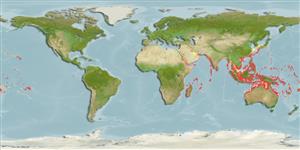>
Clupeiformes (Herrings) >
Spratelloididae (Small round herrings)
Etymology: Spratelloides: Old German, sprotte (1611) = a small fish, Clupea sp. + Greek, suffix, oides = similar to (Ref. 45335).
More on author: Bennett.
Issue
The species in the genera Spratelloides Bleeker, 1851 and Jenkinsia Jordan & Evermann, 1896 should most probably be assigned to a separated family from Clupeidae and Dussumieriidae (Lavoué, pers. comm., July 2013). See a preliminary analysis in Lavoué et al. (2013: Ref. 93878).
Environment: milieu / climate zone / depth range / distribution range
экология
морской ассоциированный с рифами; пределы глубины 0 - 50 m (Ref. 188). Tropical; 40°N - 29°S, 29°E - 143°W (Ref. 188)
Indo-Pacific: Red Sea and East Africa to the Society Islands (but not the Tuamoto and Marquesas islands), north to southern Japan, south to northern Australia. Single specimen from eastern Mediterranean (Tel-Aviv, Israel).
Length at first maturity / Size / Вес / Возраст
Maturity: Lm ?, range 4 - ? cm
Max length : 7.0 cm SL самец/пол неопределен; (Ref. 188)
колючие лучи спинного плавника (общее число) : 0; членистые (мягкие) лучи спинного плавника (общее число) : 11 - 13; колючие лучи анального плавника: 0; членистые (мягкие) лучи анального плавника: 10 - 11. No bright silver along band flanks, maxilla toothless; pre-maxillae triangular, 2 supra-maxillae, second supra-maxilla paddle-shaped and symmetrical; vertical striate on scales meeting at center, posterior margin of scales smooth, pre-dorsal scales 8 to 13; W-shaped pelvic scute, few branchiostegal rays (6 or 7).
Pelagic (Ref. 68964). Usually an inshore schooling species, inhabiting relatively clear coastal waters, lagoons, and along reef margins. Feeds near surface on plankton. Found in large schools (Ref. 9710). Pelagic (Ref. 58302). Marketed fresh or dried-salted (Ref. 5213) and used as tuna baitfish.
Whitehead, P.J.P., 1985. FAO Species Catalogue. Vol. 7. Clupeoid fishes of the world (suborder Clupeoidei). An annotated and illustrated catalogue of the herrings, sardines, pilchards, sprats, shads, anchovies and wolf-herrings. FAO Fish. Synop. 125(7/1):1-303. Rome: FAO. (Ref. 188)
Статус Красного Списка МСОП (Ref. 130435: Version 2024-2)
Угроза для людей
Harmless
Использование человеком
рыболовство: не имеет хозяйственного значения; наживка: usually
дополнительная информация
инструменты
Специальные отчеты
Скачать в формате XML
ресурсы в Интернет
Estimates based on models
Preferred temperature (Ref.
123201): 24.7 - 29.1, mean 28.1 °C (based on 1228 cells).
Phylogenetic diversity index (Ref.
82804): PD
50 = 0.5625 [Uniqueness, from 0.5 = low to 2.0 = high].
Bayesian length-weight: a=0.00479 (0.00290 - 0.00790), b=3.17 (3.03 - 3.31), in cm total length, based on LWR estimates for this species & (Sub)family-body (Ref.
93245).
Trophic level (Ref.
69278): 3.1 ±0.0 se; based on diet studies.
Generation time: 0.4 ( na - na) years. Estimated as median ln(3)/K based on 1
growth studies.
устойчивость к внешним воздействиям (Ref.
120179): высокий, минимальное время удвоения популяции до 15 месяцев (K=2.7-12.2; Fec=524; tm=0.14).
Fishing Vulnerability (Ref.
59153): Low vulnerability (10 of 100).
Nutrients (Ref.
124155): Calcium = 347 [102, 2,847] mg/100g; Iron = 4.79 [1.15, 18.89] mg/100g; Protein = 19.7 [16.9, 22.4] %; Omega3 = 0.179 [0.029, 1.111] g/100g; Selenium = 223 [24, 1,690] μg/100g; VitaminA = 19 [2, 208] μg/100g; Zinc = 6.8 [2.2, 18.3] mg/100g (wet weight);
